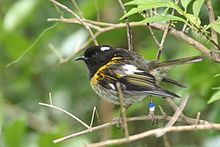This is an old revision of this page, as edited by Санта Клаус (talk | contribs) at 00:00, 12 February 2008 (ar interwiki). The present address (URL) is a permanent link to this revision, which may differ significantly from the current revision.
Revision as of 00:00, 12 February 2008 by Санта Клаус (talk | contribs) (ar interwiki)(diff) ← Previous revision | Latest revision (diff) | Newer revision → (diff)
| Passerines | |
|---|---|
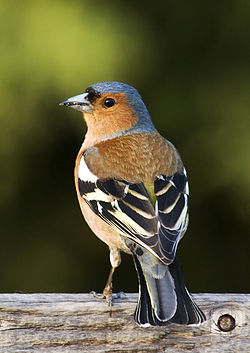
| |
| Male Chaffinch, Fringilla coelebs (Passeri: Passeroidea: Fringillidae) | |
| Scientific classification | |
| Kingdom: | Animalia |
| Phylum: | Chordata |
| Class: | Aves |
| Subclass: | Neornithes |
| Infraclass: | Neognathae |
| Superorder: | Neoaves |
| Order: | Passeriformes Linnaeus, 1758 |
| Type species | |
| Fringilla domestica Linnaeus, 1758 | |
| Suborders | |
|
and see text | |
| Diversity | |
| Roughly 100 families, around 5,400 species | |
A passerine is a bird of the gigantic order Passeriformes. More than half of all species of bird are passerines. Sometimes known as perching birds or, less accurately, as songbirds, the passerines form one of the most spectacularly diverse terrestrial vertebrate orders: with around 5,400 species, it is roughly twice as diverse as the largest of the mammal orders, the Rodentia.
The names "passerines" and "Passeriformes" derive from Passer domesticus, the scientific name of the type species – the House Sparrow – and ultimately from the Latin term passer for true sparrows and similar small birds.
Characteristics
Many passerines are songbirds and have complex muscles to control their syrinx; many gape in the nest as infants to beg for food.
The order is divided into three suborders, Tyranni (suboscines), Passeri (oscines), and the basal Acanthisitti. Oscines have the most control of their syrinx muscles among birds, producing a wide range of songs and other vocalizations (though some of them, such as the crows, do not sound musical to human beings); some such as the Lyrebird are accomplished imitators). The Acanthisitti are tiny, wren-like birds restricted to New Zealand at least in modern times; they were long included among the Passeri, but are actually a distinct and very ancient group.
Most passerines are smaller than typical members of other avian orders. The heaviest and altogether largest passerine is the Thick-billed Raven; some Common Ravens come close and the two species of Lyrebird are longer overall.
The foot of a passerine has three toes directed forward without any webbing or joining, and one toe directed backward. The hind toe joins the leg at the same level as the front toes. In other orders of birds the toe arrangement is different.
Most passerines lay coloured eggs, in contrast with non-passerines, whose eggs are white except in some ground-nesting groups such as Charadriiformes and nightjars, where camouflage is necessary, and some parasitic cuckoos, which match the passerine host's egg.
Origin and evolution
The evolutionary history of and relationships among the passerine families remained rather mysterious until around the end of the 20th century. Many passerine families were grouped together on the basis of morphological similarities that, it is now believed, are the result of convergent evolution, not a close genetic relationship. For example, the "wrens" of the northern hemisphere, those of Australia, and those of New Zealand look very similar and behave in similar ways, and yet belong to three far-flung branches of the passerine family tree; they are as unrelated as it is possible to be while remaining Passeriformes.
Much research remains to be done, but advances in molecular biology and improved paleobiogeographical data are gradually revealing a clearer picture of passerine origins and evolution. It is now thought that the first passerines evolved in Gondwana at some time in the Paleogene, maybe around the Late Paleocene some 60–55 million years ago (mya). The initial split was between the Tyranni, the songbirds, the Eurylaimides and the New Zealand "wrens", which must have diverged during a short period of time (some million years at most). The Passeriformes apparently evolved out of a fairly close-knit clade of "near passerines" which contains such birds as the Piciformes, Coraciiformes, and Cuculiformes.
A little later, a great radiation of forms took place out of Australia-New Guinea: the Passeri or songbirds. A major branch of the Passeri, "Parvorder Passerida", emerged either as the sister group to the basal lineages and corvoids ("Parvorder Corvida"), or more likely as a subgroup of it, and expanded deep into Eurasia and Africa, where there was a further explosive radiation of new lineages. This eventually led to three major passeridan lineages comprising about 4,000 species, which in addition to the corvoidan clade and numerous minor lineages make up songbird diversity today. There has been extensive biogeographical mixing, with northern forms returning to the south, southern forms moving north, and so on.
Fossil record
Perching bird osteology, especially of the limb bones, is rather diagnostic. However, the early fossil record is poor because the first Passeriformes were apparently on the small side of the present size range, and their delicate bones did not preserve well. QM specimens F20688 (carpometacarpus) and F24685 (tibiotarsus) from Murgon, Queensland are fossil bone fragments clearly recognizable as passeriform; they represent two species of approximately some 10 and some 20 cm in overall length and prove that some 55 mya, early perching birds were recognizably distinct. A quite similar group, the Zygodactylidae (named for their zygodactylous approach to perching) independently arose at much the same time – and possibly from closely related ancestors – in the landmasses bordering the North Atlantic, which at that time was only some two-thirds of its present width.
Until the discovery of the Australian fossils, it was believed for some time that Palaeospiza bella from the Priabonian Florissant Fossil Beds (Late Eocene, around 35 mya) was the oldest known passeriform. However, it is now considered a non-passeriform near passerine.

Modern knowledge about the living passerines' interrelationships (see the list of families below) suggests that the last common ancestor of all living Passeriformes was a small forest bird, probably with a stubby tail and an overall drab coloration, but possibly with marked sexual dimorphism. The latter trait seems to have been lost and re-evolved multiple times in songbird evolution alone, judging from its distribution among the extant lineages: the common ancestor of Passerida for example was almost certainly not markedly dimorphic considering the trait is very rare among the basal lineages of these, but very common among the youngest passerid clade, the Passeroidea; on the other hand among the basalmost Passeri there are a considerable number of strongly dimorphic lineages such as the very ancient Menuridae as well as many Meliphagoidea and Corvoidea. Sexual dimorphism is also not uncommon in the Acanthisittidae and prominent in some suboscines such as the Pipridae and Cotingidae.
In Europe, perching birds are not too uncommon in the fossil record from the Oligocene onwards, but most are too fragmentary for a more definite placement:
- Wieslochia (Early Oligocene of Frauenweiler, Germany)
- Passeriformes gen. et sp. indet. (Early Oligocene of Luberon, France) – suboscine or basal
- Passeriformes gen. et spp. indet. (Late Oligocene of France) – several suboscine and oscine taxa
- Passeriformes gen. et spp. indet. (Middle Miocene of France and Germany) – basal?
- Passeriformes gen. et spp. indet. (Sajóvölgyi Middle Miocene of Mátraszõlõs, Hungary) – at least 2 taxa, possibly 3; at least one probably Oscines
Wieslochia was possibly not a member of any extant suborder. That not only the Passeri expanded much beyond their region of origin is proven by an undetermined broadbill (Eurylaimidae) from the Early Miocene (roughly 20 mya) of Wintershof, Germany, and the indeterminate Late Oligocene suboscine from France listed above. Even very basal Passeriformes might have been common in Europe until the Middle Miocene, some 12 mya. Extant Passeri superfamilies were quite distinct by that time and are known since about 12–13 mya when modern genera were present in the corvoidean and basal songbirds. The modern diversity of Passerida genera is known mostly from the Late Miocene onwards and into the Pliocene (about 10–2 mya). Pleistocene and early Holocene lagerstätten (<1.8 mya) yield numerous extant species, and many yield almost nothing but extant species or their chronospecies and paleosubspecies; see also Late Quaternary prehistoric birds.
In the Americas, the fossil record is more scant before the Pleistocene, from which several still-existing suboscine families are documented. Apart from the indeterminable MACN-SC-1411 (Pinturas Early/Middle Miocene of Santa Cruz Province, Argentina), an extinct lineage of perching birds has been described from the Late Miocene of California, USA: the Palaeoscinidae with the single genus Paleoscinis. "Palaeostruthus" eurius (Pliocene of Florida) probably belongs to an extant family, most likely passeroidean.
Systematics and taxonomy

Initially, the Corvida and Passerida were classified as "parvorders" in the suborder Passeri; in accord with the usual taxonomic practice, they would probably be ranked as infraorders. As originally envisioned in the Sibley-Ahlquist taxonomy, they contained, respectively, the large superfamilies Corvoidea and Meliphagoidea as well as minor lineages, and the superfamilies Sylvioidea, Muscicapoidea and Passeroidea.
This arrangement has been found to be overly simplified by more recent research. Since the mid 2000s, literally dozens of studies are being published which try rather successfully to resolve the phylogeny of the passeriform radiation. For example, the Corvida in the traditional sense were a rather arbitrary assemblage of early and/or minor lineages of passeriform birds of Old World origin, generally from the region of Australia, New Zealand, and Wallacea. The Passeri on the other hand can be made monophyletic by moving some families about, but the "clean" three-superfamily-arrangement has turned out to be far more complex and it is uncertain whether future authors will stick to it.
Several taxa turned out to represent highly distinct species-poor lineages and consequently new families had to be established, some of them – like the Stitchbird of New Zealand and the Eurasian Bearded Reedling – monotypic with only one living species.. It seems likely that in the Passeri alone, a number of minor lineages will eventually be recognized as distinct superfamilies. For example, the kinglets constitute a single genus with less than 10 species today, but seem to have been among the first perching bird lineages to diverge as the group spread across Eurasia. No particularly close relatives of them have been found among comprehensive studies of the living Passeri, though it is suspected that they might be fairly close to some little-studied tropical Asian groups. Major "wastebin" families such as the Old World warblers and Old World babblers have turned out to be paraphyletic and are being rearranged.
This process is still continuing. Therefore, the arrangement as presented here is subject to change. However, it should take precedence over unreferenced conflicting treatments in family, genus and species articles here; see the next section for default sources.
Taxonomic list of Passeriformes families

This list is in taxonomic order, placing related species/groups next to each other. The Passerida subdivisions are updated as needed from the default sequence of the Handbook of the Birds of the World, based on the most modern and comprehensive studies. Updates are added as necessary.
Regarding arrangement of families
The families are sorted into a somewhat unusual sequence. This is because so many reallocations have taken place since about 2005 that a definite arrangement has not been established yet. The present sequence is an attempt to preserve as much of the traditional sequence while giving priority to adequately addressing the relationships between the families.
Suborder Acanthisitti
- Acanthisittidae: New Zealand "wrens"

Suborder Tyranni
Suboscines
- Infraorder Eurylaimides – Old World suboscines (or Broad-billed suboscines). Probably a separate suborder.
- Superfamily Eurylaimoidea – broadbills and allies
- Eurylaimidae: broadbills
- Philepittidae: asities
- Sapayoidae: Broad-billed Sapayoa
- Superfamily Pittoidea
- Pittidae: pittas
- Superfamily Eurylaimoidea – broadbills and allies
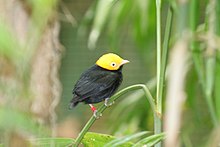
- Infraorder Tyrannides - New World suboscines
- Superfamily N.N. – "bronchophones"
- Tyrannidae: tyrant flycatchers
- Tityridae: tityras and allies.
- Cotingidae: cotingas
- Pipridae: manakins
- Superfamily Furnarioidea - tracheophones
- Furnariidae: ovenbirds and woodcreepers
- Thamnophilidae: antbirds
- Formicariidae: antpittas, antthrushes and typical tapaculos. Possibly polyphyletic.
- Conopophagidae: gnateaters and gnatpittas
- N.N.: atypical "tapaculos" (crescent-chests and allies)
- Superfamily N.N. – "bronchophones"
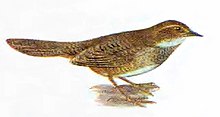
Suborder Passeri
Songbirds or oscines
- Basal Passeri – the most ancient true songbirds, endemic to Australia. Sometimes considered a superfamily "Menuroidea".
- Menuridae: lyrebirds
- Atrichornithidae: scrub-birds
- Superfamily Meliphagoidea – mainly insectivores and nectarivores, distribution centered on Australo-Melanesian region extending into surroundings, notably the Pacific.

New Holland Honeyeater (Phylidonyris novaehollandiae) - Maluridae: fairy-wrens, emu-wrens and grasswrens
- Dasyornithidae: bristlebirds. Formerly in Acanthizidae.
- Acanthizidae: scrubwrens, thornbills, and gerygones
- Meliphagidae: honeyeaters
- Meliphagoidea incertae sedis
- Pardalotidae: pardalotes. Formerly in Acanthizidae, might be included in Meliphagidae.
- Acanthorhynchus: spinebills. Usually included in Meliphagidae; might be considered a monotypic family if Pardalotidae are considered valid too.
- Superfamily Corvoidea – a highly diverse group of global distribution, but most plentiful in the Australasian region and surroundings. The oldest truly globally successful group of passerines, they include among them what may well be the most intelligent and the most spectacular of the order.
Male Stitchbird or hihi (Notiomystis cincta) showing convergence with honeyeaters. 
Yellow-crowned Gonolek (Laniarius barbarus: Malaconotidae) 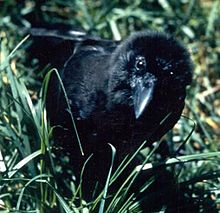
The Hawaiian Crow or ʻalala (Corvus hawaiiensis) is nearly extinct; only a few dozen birds survive in captivity. - Melanocharitidae: berrypeckers and longbills. Formerly in Passerida.
- Callaeidae: New Zealand wattlebirds. Tentatively placed here.
- Family N.N.: Stitchbird. Tentatively placed here.
- Cnemophilidae: satinbirds
- Neosittidae: sittellas
- Vireonidae: vireos
- Campephagidae: cuckoo-shrikes and trillers
- Pachycephalidae: whistlers and allies. Delimitation with regards to several proposed families and subfamilies requires thorough study.
- Oriolidae: orioles and Figbird
- Paramythiidae: Tit Berrypecker and Crested Berrypecker. Formerly in Passerida.
- Artamidae: woodswallows, butcherbirds, currawongs and Australian Magpie
- Malaconotidae: puffback shrikes, bush shrikes, tchagras and boubous
- Platysteiridae: wattle-eyes. Formerly in Passerida. Probably paraphyletic.
- Aegithinidae: ioras
- Pityriaseidae: Bornean Bristlehead. Tentatively placed here.
- Prionopidae: helmetshrikes
- Vangidae: vangas
- Dicruridae: drongos, monarch flycatchers, fantails and allies. Probably paraphyletic; supposed subfamilies Monarchinae and Rhipidurinae better considered 2–3 distinct families again.
- Paradisaeidae: birds of paradise
- Corcoracidae: White-winged Chough and Apostlebird
- Laniidae: shrikes
- Corvidae: crows, ravens and jays
- Corvoidea incertae sedis
- Vireolanius: shrike-vireos. Usually included in Vireonidae, possibly a monotypic family,
- Erpornis: White-bellied Erpornis. Formerly in Yuhina (Passerida: Timaliidae); possibly a monotypic family, possibly in Vireonidae
- Colluricinclidae: shrike-thrushes. Often included in Pachycephalidae but perhaps recognizable as a subfamily at least.
- Cinclosomatidae: whipbirds and allies. Contains Psophodidae but that might make it paraphyletic. At least some species belong in Pachycephalidae if Falcunculinae are not considered a distinct family.
- Falcunculidae: Shrike-tit and allies. Usually included in Pachycephalidae; might be distinct family or merged in Cinclosomatidae or Psophodidae.
- "Pitohuidae": pitohuis. Usually included in Pachycephalidae but seem closer to Oriolidae and best considered a distinct family including Oreoica and possibly other Pachycephalidae sensu lato.

- Passeri (mainly "Corvida") incertae sedis

The tiny Goldcrest (Regulus regulus) belongs to a minor but highly distinct lineage of Passeri. - Possible superfamily "Ptilonorhynchoidea" – bowerbirds and Australian treecreepers
- Climacteridae: Australian treecreepers
- Turnagridae: Piopio (extinct)
- Ptilonorhynchidae: bowerbirds
- Possible superfamily N.N. - logrunners and pseudo-babblers
- Orthonychidae: logrunners
- Pomatostomidae: pseudo-babblers
- Petroicidae: Australian robins
- Possible superfamily N.N.
- Picathartidae: rockfowl.
- Chaetopidae: rock-jumpers. Recently split from Turdidae.
- Eupetidae: Malaysian Rail-babbler. Recently split from Cinclosomatidae.
- Possible monotypic superfamily Reguloidea – kinglets
- Regulidae: kinglets
- Possible monotypic superfamily N.N.
- Family N.N.: Hyliotas. Recently split from Sylviidae.
- Irenidae: fairy-bluebirds. Reguloidea? Basal to/in Passeroidea?
- Chloropseidae: leafbirds. Reguloidea? Basal to/in Passeroidea?
- Possible superfamily "Ptilonorhynchoidea" – bowerbirds and Australian treecreepers
Infraorder Passerida

- Superfamily Sylvioidea – mostly insectivores, distribution centered on the Indo-Pacific region. Few occur in the Australian region and fewer still in the Americas. Usually sleek and drab birds, few have pronounced sexual dimorphism.

Blyth's Reed-warbler (Acrocephalus dumetorum) is now in the Acrocephalidae. - Alaudidae: larks
- Hirundinidae: swallows and martins
- Phylloscopidae: leaf-warblers and allies. Recently split from Sylviidae.
- Aegithalidae: long-tailed tits
- Cettiidae: ground-warblers and allies. Recently split from Sylviidae.
- Megaluridae: grass-warblers and allies. Recently split from Sylviidae.
- "Bernieridae": Malagasy warblers. A newly assembled family.
- Acrocephalidae: marsh- and tree-warblers. Recently split from Sylviidae.
- Pycnonotidae: bulbuls
- Cisticolidae: cisticolas and allies
- Sylviidae: "true/sylviid warblers" and parrotbills. Might be merged in Timaliidae. Monophyly needs confirmation.
- Zosteropidae: white-eyes. Probably belongs in Timaliidae.
- Timaliidae: (Old World) babblers. Monophyly needs confirmation.
- Sylvioidea incertae sedis
- "African warblers": A proposed clade, but monophyly needs confirmation. Formerly in Sylviidae.
- Donacobius: Black-capped Donacobius. Monotypic family? Tentatively placed here; possibly closest to Megaluridae. Formerly in Troglodytidae and Mimidae.
- Nicator: Relationships unresolved, monotypic family? Tentatively placed here; formerly in Pycnonotidae.

Hermit Thrush (Catharus guttatus), like many Muscicapoidea a stout and cryptic bird with complex vocalizations.
- Superfamily Muscicapoidea – mostly insectivores, near-global distribution centered on Old World tropics. One family endemic to Americas. Nearly absent (except introductions) from the Australian region. Usually rather stocky for their size, most are quite dark and dull though Sturnidae are commonly iridescent and/or colorful. Sexual dimorphism often absent, sometimes pronounced.
- Cinclidae: dippers
- Muscicapidae: Old World flycatchers and chats. Monophyly needs confirmation.
- Turdidae: thrushes and allies. Monophyly needs confirmation.
- Buphagidae: oxpeckers. Formerly usually included in Sturnidae.
- Sturnidae: starlings and possibly Philippine creepers. Placement of latter in Muscicapoidea seems good, but inclusion in Sturnidae requires confirmation; possibly distinct family Rhabdornithidae.
- Mimidae: mockingbirds and thrashers
- Superfamily Passeroidea – mostly herbivores including many seed-eaters, near-global distribution centered on Palearctic and Americas. Includes the Nine-primaried oscines (probably a subclade). A very high proportion of colorful and highly sexually dimorphic forms.

Like the Chaffinch above, these male (right) and female Gouldian Finches (Erythrura gouldiae), ... 
... and this Green-and-gold Tanager (Tangara schrankii), many Passeroidea are very colorful. - Passeridae: true sparrows
- Prunellidae: accentors
- Motacillidae: wagtails and pipits
- Urocynchramidae: Przewalski's Finch. Recently split from Fringillidae; tentatively placed here.
- Peucedramidae: Olive Warbler
- Estrildidae: estrildid finches (waxbills, munias, etc)
- Ploceidae: weavers
- Viduidae: indigobirds and whydahs
- Fringillidae: true finches and Hawaiian honeycreepers. Possibly polyphyletic.
- Icteridae: grackles, New World blackbirds, and New World orioles
- Parulidae: New World warblers
- Thraupidae: tanagers and allies
- Cardinalidae: cardinals
- Emberizidae: buntings and American sparrows
- Passeroidea incertae sedis
- Coerebidae: Bananaquit. Family invalid or not monotypic; reallocation pending.
- Passerida incertae sedis - Rather basal Passerida, most of which seem to constitute several small but distinct lineages that could be considered superfamilies. Most occur in Asia, Africa and North America.
- Panurus: Bearded Reedling (Bearded "Tit"). Relationships enigmatic. Formerly in "Paradoxornithidae", might be included in Sylvioidea as monotypic family Panuridae or even constitute the smallest passerine superfamily.
- Possible superfamily Paroidea – titmice and allies. Might be included in Sylvioidea.

The Blue Tit (Cyanistes caeruleus) and its relatives stand well apart from rest of the Sylvioidea sensu lato. - Paridae: tits, chickadees and titmice
- Remizidae: penduline tits. Sometimes included in Paridae.
- Stenostiridae: stenostirids ("flycatcher-tits"). A newly assembled family; sometimes included in Paridae.
- Possible superfamily Sittoidea or Certhioidea - wrens and allies. Might be included in Muscicapoidea.

The Bohemian Waxwing (Bombycilla cedrorum) and its relatives seem closer to the Muscicapoidea sensu stricto than to most other passerines. - Sittidae: nuthatches
- Tichodromadidae: Wallcreeper. Tentatively placed here.
- Certhiidae: treecreepers
- Salpornithidae: Spotted Creeper. Tentatively placed here; might belong in Certhidae.
- Troglodytidae: wrens
- Polioptilidae: gnatcatchers
- Possible superfamily Bombycilloidea – waxwings and allies. Included in Muscicapoidea if Sittoidea/Certhioidea are not considered a distinct superfamily.
- Bombycillidae: waxwings
- Dulidae: Palmchat. Tentatively placed here.
- Ptilogonatidae: silky flycatchers. Tentatively placed here.
- Hypocoliidae: Hypocolius. Tentatively placed here.
- Possible superfamily "Dicaeoidea" – sunbirds and flowerpeckers. Might be included in Passeroidea.
- Nectariniidae: sunbirds
- Dicaeidae: flowerpeckers
- Possible monotypic superfamily N.N.
- Promeropidae: sugarbirds. Might be included in Passeroidea.
Footnotes
- Johansson & Ericson (2003)
- See e.g. Boles (1997), Manegold et al. (2004), Mayr & Manegold (2006)
- Boles (1997)
- The last common ancestor of all songbirds most likely had a decidedly longer tail. See del Hoyo et al. (2003, 2004).
- Specimen SMF Av 504. A flattened right hand of a passerine perhaps 10 cm long overall. If suboscine, perhaps closer to Cotingidae than to Eurylaimides: Roux (2002), Mayr & Manegold (2006)
- Huguenet et al. (2003), Mayr & Manegold (2006)
- Specimens SMF Av 487-496; SMNS 86822,86825-86826; MNHN SA 1259–1263: tibiotarsus remains of small, possibly basal Passeriformes: Manegold et al. (2004)
- A partial coracoid of a probably Muscicapoidea, possibly Turdidae; distal tibiotarsus and tarsometatarsus of a smallish to mid-sized passerine which may be the same as the preceding; proximal ulna and tarsometatarsus of a Paridae-sized passerine: Gál et al. (1998-1999, 2000)
- Manegold et al. (2004)
- Distal right humerus, possibly suboscine: Noriega & Chiappe (1991, 1993)
- The former does not even have recognized subspecies, while the latter is one of the most singular birds alive today. Good photos of a Bearded Reedling are for example here and here.
- del Hoyo et al. (2003-)
- Lovette & Bermingham (2000), Cibois et al. (2001), Barker et al. (2002, 2004), Ericson & Johansson (2003), Beresford et al. (2005), Alström et al. (2006), Jønsson & Fjeldså (2006)
References
- Alström, Per; Ericson, Per G.P.; Olsson, Urban & Sundberg, Per (2006): Phylogeny and classification of the avian superfamily Sylvioidea. Mol. Phylogenet. Evol. 38(2): 381–397. doi:10.1016/j.ympev.2005.05.015
- Barker, F. Keith; Barrowclough, George F. & Groth, Jeff G. (2002): A phylogenetic hypothesis for passerine birds: taxonomic and biogeographic implications of an analysis of nuclear DNA sequence data. Proc. R. Soc. B 269(1488): 295-308. doi:10.1098/rspb.2001.1883 PDF fulltext
- Barker, F. Keith; Cibois, Alice; Schikler, Peter A.; Feinstein, Julie & Cracraft, Joel (2004): Phylogeny and diversification of the largest avian radiation. PNAS 101(30): 11040-11045. doi:10.1073/pnas.0401892101 PDF fulltext Supporting information
- Beresford, P.; Barker, F.K.; Ryan, P.G. & Crowe, T.M. (2005): African endemics span the tree of songbirds (Passeri): molecular systematics of several evolutionary 'enigmas'. Proc. Roy. Soc. Lond. B 272(1565): 849–858. doi:10.1098/rspb.2004.2997 PDF fulltext Electronic appendix
- Boles, Walter E. (1997): Fossil Songbirds (Passeriformes) from the Early Eocene of Australia. Emu 97(1): 43-50. doi:10.1071/MU97004
- Cibois, Alice; Slikas, Beth; Schulenberg, Thomas S. & Pasquet, Eric (2001): An endemic radiation of Malagasy songbirds is revealed by mitochondrial DNA sequence data. Evolution 55(6): 1198-1206. DOI:10.1554/0014-3820(2001)0552.0.CO;2 PDF fulltext
- del Hoyo, J.; Elliot, A. & Christie, D. (eds.) (2003): Handbook of the Birds of the World (Vol. 8: Broadbills to Tapaculos). Lynx Edicions. ISBN 8487334504
- del Hoyo, J.; Elliot, A. & Christie, D. (eds.) (2004): Handbook of the Birds of the World (Vol. 9: Cotingas to Pipits and Wagtails. Lynx Edicions). ISBN 8487334695
- del Hoyo, J.; Elliot, A. & Christie, D. (eds.) (2005): Handbook of the Birds of the World (Vol. 10: Cuckoo-Shrikes to Thrushes. Lynx Edicions). ISBN 8487334725
- del Hoyo, J.; Elliot, A. & Christie, D. (eds.) (2006): Handbook of the Birds of the World (Vol. 11: Old World Flycatchers to Old World Warblers). Lynx Edicions. ISBN 849655306X
- del Hoyo, J.; Elliot, A. & Christie, D. (eds.) (2007): Handbook of the Birds of the World (Vol. 12: Picathartes to Tits and Chickadees). Lynx Edicions. ISBN 9788496553422
- Dickinson, E.C. (ed.) (2003): The Howard and Moore complete checklist of the birds of the World (3rd edition). Christopher Helm, London. ISBN 071366536X
- Ericson, Per G.P. & Johansson, Ulf S. (2003): Phylogeny of Passerida (Aves: Passeriformes) based on nuclear and mitochondrial sequence data. Mol. Phylogenet. Evol. 29(1): 126–138 doi:10.1016/S1055-7903(03)00067-8 PDF fulltext
- Gál, Erika; Hír, János; Kessler, Eugén & Kókay, József (1998-99): Középsõ-miocén õsmaradványok, a Mátraszõlõs, Rákóczi-kápolna alatti útbevágásból. I. A Mátraszõlõs 1. lelõhely . Folia Historico Naturalia Musei Matraensis 23: 33-78. PDF fulltext
- Gál, Erika; Hír, János; Kessler, Eugén, Kókay, József & Márton, Venczel (2000): Középsõ-miocén õsmaradványok a Mátraszõlõs, Rákóczi-kápolna alatti útbevágásból II. A Mátraszõlõs 2. lelõhely . Folia Historico Naturalia Musei Matraensis 24: 39-75. PDF fulltext
- Hugueney, Marguerite; Berthet, Didier; Bodergat, Anne-Marie; Escuillié, François; Mourer-Chauviré, Cécile & Wattinne, Aurélia (2003): La limite Oligocène-Miocène en Limagne: changements fauniques chez les mammifères, oiseaux et ostracodes des différents niveaux de Billy-Créchy (Allier, France) . Geobios 36(6): 719–731. doi:10.1016/j.geobios.2003.01.002 (HTML abstract)
- Johansson, Ulf S. & Ericson, Per G.P. (2003): Molecular support for a sister group relationship between Pici and Galbulae (Piciformes sensu Wetmore 1960). J. Avian Biol. 34(2): 185–197. doi:10.1034/j.1600-048X.2003.03103.x PDF fulltext
- Jønsson, Knud A. & Fjeldså, Jon (2006): A phylogenetic supertree of oscine passerine birds (Aves: Passeri). Zool. Scripta 35(2): 149–186. Error: Bad DOI specified! (HTML abstract)
- Lovette, Irby J.& Bermingham, Eldredge (2000): c-mos Variation in Songbirds: Molecular Evolution, Phylogenetic Implications, and Comparisons with Mitochondrial Differentiation. Mol. Biol. Evol. 17(10): 1569–1577. PDF fulltext
- Mayr, Gerald & Manegold, Albrecht (2006): A Small Suboscine-like Passeriform Bird from the Early Oligocene of France. Condor 108(3): 717-720. DOI:10.1650/0010-5422(2006)1082.0.CO;2 HTML abstract
- Manegold, Albrecht; Mayr, Gerald & Mourer-Chauviré, Cécile (2004): Miocene Songbirds and the Composition of the European Passeriform Avifauna. Auk 121(4): 1155–1160. DOI:10.1642/0004-8038(2004)1212.0.CO;2 Imageless HTML fulltext
- Noriega, Jorge I. & Chiappe, Luis M. (1991): El más antiguo Passeriformes de America del Sur. Presentation at VIII Journadas Argentinas de Paleontologia de Vertebrados. Abstract in Ameghiniana 28(3-4): 410 . Google Books fulltext
- Noriega, Jorge I. & Chiappe, Luis M. (1993): An Early Miocene Passeriform from Argentina. Auk 110(4): 936-938. PDF fulltext DjVu fulltext
- Roux, T. (2002): Deux fossiles d'oiseaux de l'Oligocène inférieur du Luberon. Courrier Scientifique du Parc Naturel Régional du Luberon 6: 38–57.
